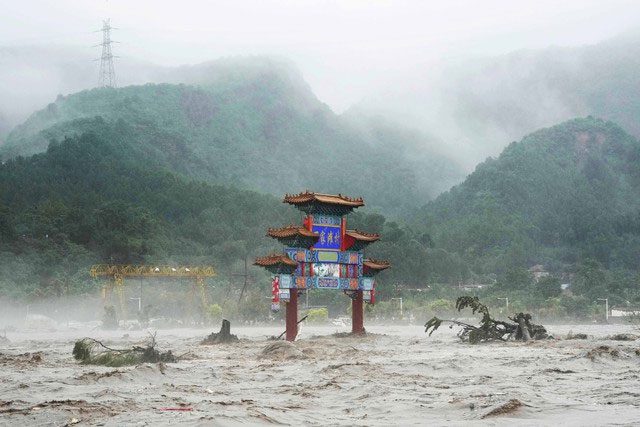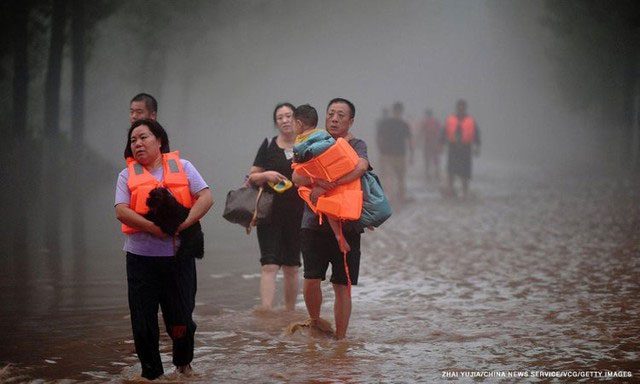Prolonged Rain and Floods Cause Severe Damage in Northern China: What Are the Causes?
In recent days, due to the impact of Typhoon Doksuri, unprecedented heavy rainfall not seen in the past 140 years has fallen across many provinces and cities in China. This has exacerbated the flood situation significantly.
Reuters reports that since making landfall in southern China, Typhoon Doksuri has led to at least 20 fatalities and the evacuation of thousands, while also causing flooding in Beijing and several other cities.
According to Xinhua News Agency, as of August 6, at least 36 people have died due to flooding in China. However, local officials are concerned that the death toll may rise further.

Heavy rains have caused widespread flooding in many cities in China in recent days. (Photo: AP).
Reuters further reported that the Ministry of Water Resources of China raised the flood response level to Level 3 at 10 AM on August 6 in Jilin city, Heilongjiang province, and the Inner Mongolia region. On the same day, the Chinese government allocated an additional 350 million yuan (nearly 49 million USD) for rescue and recovery efforts in Beijing, Hebei, Tianjin, Heilongjiang, and Jilin.
Experts state that the record-breaking heavy rainfall over an extended period combined with the arrival of Typhoon Doksuri at the end of July has caused widespread flooding and disrupted the lives of millions in northern China over the past week.
Specifically, rainfall from July 29 has broken several local records in Beijing and northern China. A reservoir in the Changping district of Beijing recorded rainfall of up to 744.8 mm from July 29 to August 2. This is also the highest rainfall ever recorded in Beijing in the past 140 years. In Hebei province, a weather station recorded up to 1,003 mm of rainfall from July 29 to 31. This amount is typically seen over 1.5 years in Hebei province.
What are the causes of the largest floods in 140 years in China?

Beijing is experiencing unprecedented flooding in the last 140 years. (Photo: Getty Images).
Chinese meteorologists indicate that, in addition to the remnants of Typhoon Doksuri, warm and humid air currents along with moisture from the slowly moving Typhoon Khanun in the western Pacific have contributed to the heavy rains in the country over the past few days.
Specifically, as the rain clouds from Typhoon Doksuri moved towards northern China, a high-pressure system in the continental and subtropical atmosphere blocked their path. This led to the continuous convergence of moisture, acting like a dam holding water.
Moreover, meteorologists noted that the area’s topographical features also contributed to the heavy rains occurring in many cities in China. Initially, a large amount of moisture concentrated in northern China and was then lifted by low-level winds, shifting rainfall eastward of the Taihang Mountains, where the hardest-hit areas include the Mentougou district and the Fangshan district of Beijing.

Rescue operations in the affected cities in China are ongoing. (Photo: SCMP).
Meanwhile, a series of convective clouds concentrated over the area has led to prolonged heavy rainfall. This has resulted in damages across many cities in China and complicated rescue efforts.
As Typhoon Doksuri weakened, Typhoon Khanun strengthened in the western Pacific and approached the coastal areas of China. The interaction between the two storms increased rainfall and led to widespread impacts.
Evidence of this can be seen in urban areas of Beijing, where hundreds of roads were flooded, forcing parks and tourist attractions to close. Additionally, hundreds of flights were delayed or canceled at the city’s two major airports.
The impact of the rains was even more pronounced in the suburbs of western Beijing. In the Fangshan and Mentougou districts, floodwaters overflowed onto the roads, sweeping away vehicles. Villages in mountainous regions were even isolated by the floods, prompting local authorities to deploy helicopters to drop food, water, and emergency supplies to residents.


















































